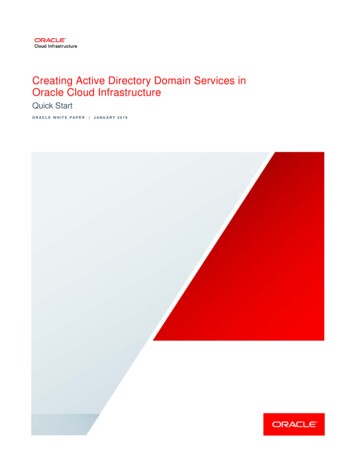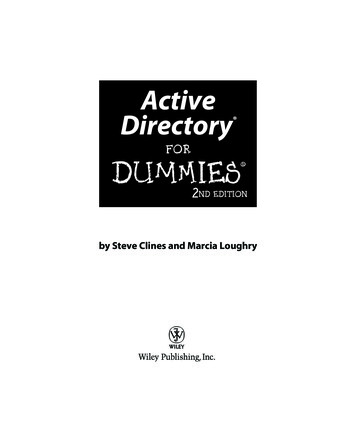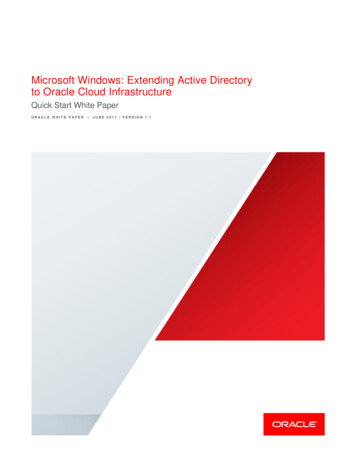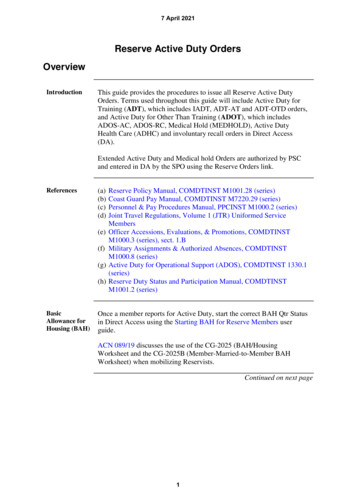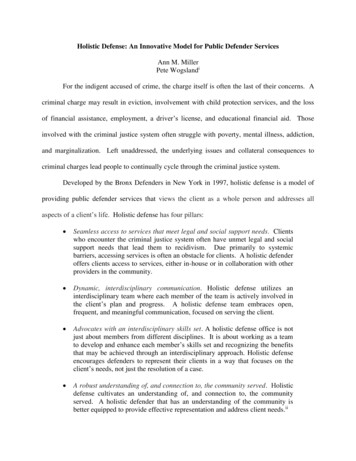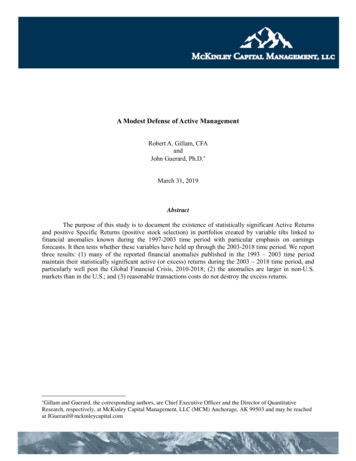
Transcription
A Modest Defense of Active ManagementRobert A. Gillam, CFAandJohn Guerard, Ph.D. March 31, 2019AbstractThe purpose of this study is to document the existence of statistically significant Active Returnsand positive Specific Returns (positive stock selection) in portfolios created by variable tilts linked tofinancial anomalies known during the 1997-2003 time period with particular emphasis on earningsforecasts. It then tests whether these variables have held up through the 2003-2018 time period. We reportthree results: (1) many of the reported financial anomalies published in the 1993 – 2003 time periodmaintain their statistically significant active (or excess) returns during the 2003 – 2018 time period, andparticularly well post the Global Financial Crisis, 2010-2018; (2) the anomalies are larger in non-U.S.markets than in the U.S.; and (3) reasonable transactions costs do not destroy the excess returns. Gillam and Guerard, the corresponding authors, are Chief Executive Officer and the Director of QuantitativeResearch, respectively, at McKinley Capital Management, LLC (MCM) Anchorage, AK 99503 and may be reachedat JGuerard@mckinleycapital.com
I.INTRODUCTIONThis applied investment research report is written from the perspective of a quantitative researcherworking in a Wall Street environment for the past 30-plus years. For the sake of simplicity, let us assume a1986 start date, as was reported in Guerard and Markowitz (2019). We share four major insights with ourstakeholders in this report. First, we report the continued statistical significance of the McKinley CapitalManagement Public (MCM) model of forecasted earnings acceleration, CTEF, in producing significantActive Returns and Specific Returns, stock selection, in Non-U.S. and global stock universes. Second,CTEF and robust-regression models of stock selection models produce optimized portfolios that deliverhighly significant Active and Specific Returns in Non-U.S. stocks. Have markets and stock selectionmodels changed since Guerard and Mark (2003) and Guerard et al. (2013) published their studies? No,CTEF and robust regression models still dominate most other models, including the 36 models tested inGuerard et al. (2018), including the Post-Global Financial Crisis period. Third, we have tested manycommercially available risk models and we report, over the past 7-9 years, that there are several risk modelscapable of producing highly statistically significant Active and Specific Returns. However, we at MCMuse the Axioma Statistical Risk Model because of its performance in MCM research competitions (the“Horse Race)” and its integration with the ITG cost curves data. Fourth, Guerard et al. (2018) also showthat updated models pass the Level III Data Mining Corrections test of Markowitz and Xu (1994) forstatistical significance. Models will never be perfect, but their portfolios can be statistically significant.Financial anomalies and regularities in returns have been studied for over 80 years in the U.S. Ifthese patterns are both persistent and observable, investors should incorporate this information into theirdecision-making, financial plans and portfolio construction; even despite the noise of the day, financialmedia and distractions associated with investing. The importance of taking account of return regularities inportfolios and plans arises because these patterns may reflect premia serving as a reward for risk-taking orbecause they represent classical measures of “alpha.” Of extreme importance to individual and institutional2
investors alike is whether they are on the “other side of the trade” and whether they are risk-sharing inmarkets or giving up alpha to smarter investors.Specifically, we test a set of U.S. and Non-U.S. variables over the past 15 years, despite rumors tothe contrary, and find that many of these fundamental, earnings forecasts, revisions, and breadth variableshave maintained their importance for returns. Moreover, earnings forecasting model excess returns aregreater in Non-U.S. and Global markets than in the U.S. markets in their post-publication time period,including booms, recessions, and highly volatile market conditions. Overall, we find that non-U.S. andEmerging Markets portfolios, built on quantitative-based variables and models, have produced statisticallysignificant Active Returns and positive Specific Returns (positive stock selection) for 5-years, 10-years,and since-inception. The underlying Quant Models, built on anomalies known at the time, haveoutperformed indexes in over 70-80% of the years.The Efficient Markets Hypothesis (EMH) dates back to Roberts (1959) and his three forms ofefficiency. The EMH simply put, held that stock prices reflected information. The weak form of the EMHheld that all past stock prices and volume information was incorporated into share prices. Hence, technicalanalysis would not produce statistically significant excess returns. The semi-strong form held that all publicinformation, such as earnings, stock splits, earnings forecast, merger announcements, and Federal Reserveannouncements were incorporated into share prices, Fama (1970, 1976). Hence, fundamental analysiswould not produce statistically significant excess returns. The third form, the strong form, held that allinformation was incorporated into share prices. Hence, non-public information such as fund performanceand insider trading would not produce statistically significant excess returns. To the contrary, the authorswill report highly statistically significant excess returns above transactions costs, and data miningcorrections adjustments in U.S. and non-U.S. stocks during the 2003-2018 time period, using modelspublished by the authors in 1993 and 1997.Fama (1976) assumes all events happen at discrete time, 𝑡 1, 𝑡, 𝑡 1. He defines Φ𝑡 1 set of information available at the time 𝑡 1 to determine stock prices at 𝑡 1.𝑚Φ𝑡 1 set of information the market uses to determine stock prices at time 𝑡 13
𝑝𝑗 , 𝑡 1 price of stock j at time 𝑡 1j 1, 2, ., n where n is the number of stocks in the market𝑓𝑚 (𝑝1 , 𝑡 𝜏, , 𝑝𝑛 , 𝑡 𝜏 Φ𝑚 joint profitability density 𝑡 1 function for stock prices𝑚at time 𝑡 𝜏 assessed by the market at time 𝑡 1, based on information Φ𝑡 1.An efficient capital market is written as:𝑚Φ𝑡 1 Φ𝑡 1(1)That is the market uses all available information.A one period price relative return is written:𝑅̃𝑗𝑡 ̃𝑗 𝑡 𝑝𝑗 , 𝑡 1𝑝(2)𝑝𝑗 , 𝑡 1Stock return is given by:𝐸𝑚 (𝑅̃𝑗𝑡 Φ𝑡 1 ) The market sets 𝑝𝑗 ,𝑡 1̃𝑗 𝑡 Φ𝑚𝑝𝑡 1 𝑝𝑗𝑡𝑝𝑗 , 𝑡 1(3)and most empirical evidence pre-2000 supported the weak form of the EMH.1A second market efficiency test is concerned with the speed of price adjustments to publiclyavailable information. Stock returns conform to the market model. The semi-strong test is used inconjunction with announcements of stock splits, earnings, new share issues, mergers, and earningsforecasting. In table tests, we test if the table joint distribution of different stock prices is multivariatenormal. That is, we use the CAPM relationship of risk and return to establish the tests of the value of publicinformation.𝐸(𝑅̃𝑗𝑡 Φ𝑡 1 , 𝑅𝑚𝑡 ) 𝛼𝑗 𝛽𝑗 𝑅𝑚𝑡𝛽 1𝑐𝑜𝑣 (𝑅̃𝑗 , ̃𝑅𝑚 )𝜎 2 𝑅̃𝑚𝑡(4)(5)𝛼𝑗 𝐸(𝑅̃𝑗𝑡 Φ𝑡 1 ) 𝛽𝑗 𝐸(𝑅𝑚𝑡 Φ𝑡 1 )(6)𝑅̃𝑗𝑡 𝛼𝑗 𝛽𝑗 𝑅̃𝑚𝑡 𝜀̃𝑗𝑡(7)See Lo, Mamaysky, and Wang (2000) for an outstanding modern test of technical analysis.4
For efficiency:𝐸(𝜀𝑗𝑡 Φ𝑡 1 , 𝑅𝑚𝑡 ) 0(8)WHAT WE KNEW IN 1991: TESTS OF FUNDAMENTAL DATAII.What did we know in 1991? What did we know in 2003? What did you know in August 2005?Students had been taught since Graham and Dodd (1934), Williams (1938), Graham, Dodd, and Cottle(1962), Loeb (1971), Graham (1973), Latane, Tuttle, and Jones (1975), and Dremen (1979) thatfundamental data, earnings, cash flow, book value, net current asset value, and sales, drove stock returns.The books supported the “low price-earnings (P/E)” multiple. Stocks with low P/Es outperformed highP/Es. Basu (1977) reported recent support for the low P/E strategy. The fundamental data wascomplemented with small size, institutional holdings, earnings forecasts, revisions, recommendations andbreadth, earnings surprises, insider trading, dividend yield, and momentum variables, being identified inDimson (1988), Jacobs and Levy (1988).2 These variables had been statistically tested, after removingmarket effects, and were reported as producing excess returns (adjusting for risk) and they declaredanomalies. Chan et al. (1991), Bloch, et al. (1993), Fama and French (1992), Ziemba and Schwartz (1992)and Haugen and Baker (1996) discussed many of the earlier reported non-U.S. anomalies and /or comparedU.S. and non-U.S. anomalies.There is an extensive body of literature on the impact of individual value ratios and variables onthe cross-section of stock returns in the pre-2002 time period. For example, Bloch et al. (1993) used relativeratios as well as current ratio values in analyzing eight factors to understand the relative explanatory powerof each in an equation to estimate the determinants of total stock returns, TR. They refer to this model asREG8.TR w0 w1EP w2BP w3CP w4SP w5REP w6RBP w7RCP w8RSP etwhere:2EP (9)[earnings per share]/[price per share] earnings-price ratio;See Levy (1999) for a most tabular list of well-known financial anomalies.5
BP [book value per share]/[price per share] book-price ratio;CP [cash flow per share]/[price per share] cash flow-price ratio;SP [net sales per share]/[price per share] sales-price ratio;REP [current EP ratio]/[average EP ratio over the past five years];RBP [current BP ratio]/[average BP ratio over the past five years];RCP [current CP ratio]/[average CP ratio over the past five years]; andRSP rs];Financial models are plagued by both outliers, influential observations that may distort regression lines andhypothesis testing, and multicollinearity, high correlation among independent variables. Both issues wereaddressed in Bloch et al. (1993).III.WHAT WE KNEW IN 1997: TESTS OF FUNDAMENTAL DATA AND EARNINGSEXPECTATIONSBruce and Epstein (1994)3 provided a summary of key studies of the effectiveness of corporateearnings forecasting variables. Further, Brown (2000) contained over 500 abstracts of studies usingInstitutional Broker Estimation Services (I/B/E/S) data.4 By 1997, it was known that Consensus TemporaryEarnings Forecast (CTEF), a composite model of I/B/E/S consensus-based earnings yield forecasts,earnings revisions, and earnings breadth (the agreement among analysts’ revisions) produced highlystatistically significant correlates of stock returns. Furthermore Guerard, Stone, and Gultekin (1997)3The Bruce and Epstein and Brown works contain much of the rich history of earnings forecasting and resultingexcess returns. Bruce and Epstein included workers the work of researchers such as Elton, Gruber, and Gultekin,who developed I/B/E/S database and published the initial research (1981 and 1984). Hawkins, Chamberlain, andDaniel (1984), the heads of IBES as it was then known, developed tests for analyst revisions. Guerard and Stone(1992), which tested time series model forecasts versus analysts’ forecasts. The Elton et al. (1981) paper is one mostinfluential analyses in earnings forecasting and security analysis. Wheeler found statistically significant excessreturns from the breadth strategy. Thus, earnings forecasts per share, earnings forecast revisions, and earningsforecast breadth had all been documented by 1994. Guerard, Markowitz, and Xu (2015) reported that the 1990searnings forecasting anomalies continued to statistically significantly enhance portfolio returns.4Analysts’ forecasts of earnings per share (eps), eps revision, and the direction of eps forecast revisions wereincorporated into the Institutional Broker Estimation Services (I/B/E/S) in-print database in July 1972. The I/B/E/Sdatabase has computer-readable data from January 1976, domestically, and January 1987, internationally.6
estimated a nine-factor model, REG9, composed of REG8 plus CTEF, was highly (statistically)significantly correlated with subsequent stock returns.TRt 1 a0 a1EPt a2 BP t a3CPt a4SPt a5REPt a6RBPt a7RCPt a8RSPt a9CTEFt et ,(10)where:EP [earnings per share]/[price per share] earnings-price ratio;BP [book value per share]/[price per share] book-price ratio;CP [cash flow per share]/[price per share] cash flow-price ratio;SP [net sales per share]/[price per share] sales-price ratio;REP [current EP ratio]/[average EP ratio over the past five years];RBP [current BP ratio]/[average BP ratio over the past five years];RCP [current CP ratio]/[average CP ratio over the past five years];RSP [current SP ratio]/[average SP ratio over the past five years];CTEF consensus earnings-per-share I/B/E/S forecast, revisions and breadth; ande randomly distributed error term.In 2005-2006, MCM launched a major research effort to “pop the hood” on its investment strategies andtest whether its factors of revisions and risk-adjusted relative return (price momentum) were statisticallysignificant. We developed the McKinley Quant (MQ) strategy of combining revisions and the risk-adjustedrelative returns models into a single proprietary score, the MQ. Higher scoring stocks were preferred, andthe semi-final nominations list (the SFL) was composed of stocks in the top three-deciles (scoring 70-99).Elton, Gruber, and Gultekin (1981) demonstrated the effectiveness of an upper three-decile strategy. In2011, MCM decided to have two models: its Public Model of forecasted earnings acceleration, its CTEFmodel, as published by the author in Guerard, Stone, Gultekin (1997), and its proprietary model offorecasted earnings acceleration, E’.7
WHAT WE KNEW IN 2012: TESTS OF FUNDAMENTAL DATA AND EARNINGSIV.EXPECTATIONSFinancial economists have empirically examined the determinants of stocks returns since Nerlove(1968). There is an equally extensive body of literature of the impact of price momentum variables on thecross-section of stock returns. Price momentum, or the non-random character of stock market prices, hadbeen studied since Bachelier in 1900, reprinted in Cootner (1964). However, influential recent researchsuch as that of Conrad and Kaul (1989), Jegadeesh and Titman (1993), Conrad and Kaul (1991, 1993,1998), and Lo et al. (2000) formalizes and extends the technical analysis and price momentum literature.5Expanding on the work of Fama and French (1998) and Guerard and Mark (2003), Guerard et al. (2012)create a ten-factor stock selection model for the U.S. expected returns that includes price momentum – theUSER model.6 Guerard et al. (2013) and Guerard and Mark (2018) apply a 10-factor model to global stocks,referring to the model as GLER (Global Equity Return), or REG10 (See equation 11). USER and GLERmodels are Public Models with (many) similar exposures to MQ in U.S. and Non-U.S. and Global stocks,respectively.TRt 1 a0 a1EPt a2 BP t a3CPt a4SPt a5REPt a6RBPt a7RCPt a8RSPt a9CTEFt a10PMt et ,(11)where:EP [earnings per share]/[price per share] earnings-price ratio;BP [book value per share]/[price per share] book-price ratio;5Most importantly for our analysis, Conrad and Kaul (1998) report the mean-reversion of stock returns inthe very short run, one week or one month, and the medium-term persistence of momentum to drive stock priceshigher in the 3, 6, 9, 12, and 18-month time horizons over the 1926 -1988 and 1926-1989 time periods. Jagadeeshand Titman (1993) construct portfolios based on six-months of positive price momentum, hold the portfolios for sixmonths, and earn excess returns of 12.01% over the 1965-1989 time period. Thus, illustrating that medium-termmomentum is an important, and persistent, risk premium. In the very long-run (24 and 36-months) Conrad and Kaul(1998) show that momentum returns become very negative. Lo et al. (2000) find over the 1962 -1996 time periodthat technical patterns produced incremental returns, particularly for NASDAQ stocks – demonstrating pricemomentum and technical analysis variables enhanced portfolio returns over the long-run.6Brush (2001) tested a PM121 price momentum variable, defined as P(t-1)/P(t-12) among a set of 7-12 pricemomentum models.8
CP [cash flow per share]/[price per share] cash flow-price ratio;SP [net sales per share]/[price per share] sales-price ratio;REP [current EP ratio]/[average EP ratio over the past five years];RBP [current BP ratio]/[average BP ratio over the past five years];RCP [current CP ratio]/[average CP ratio over the past five years];RSP [current SP ratio]/[average SP ratio over the past five years];CTEF consensus earnings-per-share I/B/E/S forecast, revisions and breadth;PM price momentum; ande randomly distributed error term.The ten-factor model was developed and tested in U.S. markets in Guerard, Xu, and Gultekin(2012) and Guerard, Markowitz, and Xu (2014), and in global markets in Guerard, Rachev, and Shao (3013)and Guerard, Markowitz, and Xu (2015). Furthermore, Deng and Min (2013) reported that the GLER modelproduces highly statistically significant active returns and better stock selections than the USER model overthe corresponding period.7 In addition, the earnings forecasting model, CTEF, and the GLER modelcontinued to produce higher statistically significant Active Returns and Specific Returns (stock selection)during the 1996 -2016 time period in Non-U.S. than U.S. markets, see Guerard, Markowitz, and Xu (2015),Guerard, Markowitz, Xu, and Wang (2018), and Guerard and Mark (2018).8V.MARKOWITZ: CONSTRUCTING MEAN-VARIANCE EFFICIENT FRONTIERSThe Markowitz (1952 and 1959) portfolio selection and construction approach is centered upon theefficient frontier, the point at which returns are maximized for a given level of risk, or risk is minimized fora given level of return. The portfolio expected return, E(Rp), is calculated by taking the sum of the security7That is, global stock selection models outperformed domestic stock selection models. Thus, U.S. investors shouldprefer global portfolios in order to maximize portfolio returns.8Guerard, Markowitz, and Xu (2015) studied the 1999 -2011 time period and Guerard, Markowitz, Xu and Wang(2018) studied the 2003 -May 2015 time period.9
weights multiplied by their respective expected returns. The portfolio standard deviation is the sum of theweighted covariances.𝑁𝐸(𝑅𝑝 ) 𝑁𝑖 1 𝑥𝑖 𝐸(𝑅𝑖 ) 𝑖 1 𝑥𝑖 𝜇𝑖(12)𝑁𝜎𝑝2 𝑁𝑖 1 𝑗 1 𝑥𝑖 𝑥𝑗 𝑐𝑖𝑗(13)where µ is the expected return vector, C is the variance-covariance matrix, and x are portfolio weights.The efficient frontier can be traced out by𝑚𝑖𝑛𝑖𝑚𝑖𝑧𝑒{𝑥𝑖 0,𝑥𝑖 𝑢̅} 𝑥 𝑇 𝐶𝑥 𝜆𝜇𝑇 𝑥(14)where λ is the risk-return tradeoff parameter and 𝑢̅ is the fixed upper bound.Risk is estimated with an k-factor index or factor model, in which the individual stock return Rj ofsecurity j at time t, dropping the subscript t for time, may be written as:̃ ̃.𝑅𝑗 𝐾𝑗𝑘 1 𝛽𝑗𝑘 𝑓𝑘 𝑒(15)The nonfactor, or asset-specific, return on security j, 𝑒̃,𝑗 is the residual risk of the security after removingthe estimated impacts of the K factors.9 The term fk is the realization or rate of return associated with factork. The factor model is used to decompose risk into systematic risk and unsystematic, or residual, risk.𝐶 𝛽𝐶𝑓,𝑓 𝛽 ′ Σ.(16)If the investor is more concerned about tracking a particular benchmark, the mean-varianceoptimization can be reformulated as a mean-variance tracking error at risk (MVTaR) optimization:9The estimation of factors, or betas, can be accomplished using firm fundamental data, as in the Rosenberg (1974),Rosenberg and Marathe (1975, 1976), Rosenberg and Marathe (1979), and Menchero et al. (2010), or principalcomponent analysis of historical stock returns, as in Blin, Bender, and Guerard (1997) and Saxena and Stubbs(2012). The reader is referred to complete and excellent surveys of multi-factor models found in Rud
Mar 31, 2019 · commercially available risk models and we report, over the past 7-9 years, that there are several risk models capable of producing highly statistically significant Active and Specific Returns. However, we at MCM use the Axioma Statistical Risk Model bec

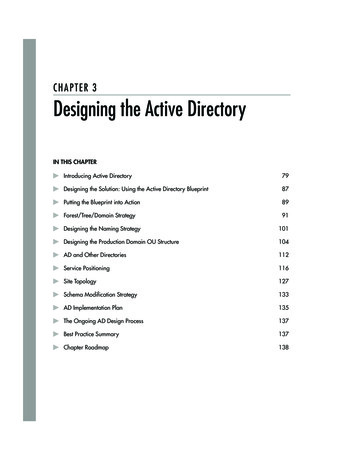

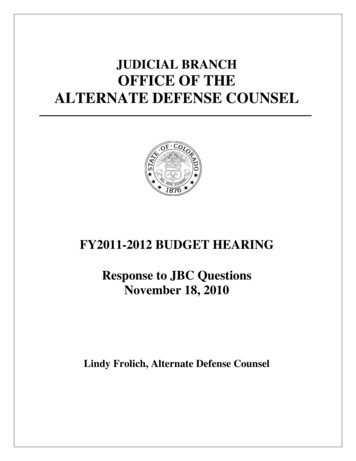
![[MS-ADFSOD]: Active Directory Federation Services (AD FS .](/img/1/5bms-adfsod-5d.jpg)
